All about Tamil Nadu
Tamil Nadu is the southernmost state of India, known for its rich history, cultural diversity, and economic significance. It ranks as the 10th largest state by area and the 6th largest by population. Tamil Nadu is the homeland of the Tamil people, who speak Tamil, one of the oldest surviving classical languages in the world. Its capital, Chennai, is a vibrant metropolitan city and a hub for commerce, culture, and education.
Situated on the southeastern coast of the Indian peninsula, Tamil Nadu is bordered by the Western Ghats and Deccan Plateau to the west, the Eastern Ghats to the north, and the Bay of Bengal to the east. Its unique geographical features include the Gulf of Mannar, the Palk Strait, and the Laccadive Sea to the southeast. The state is intersected by the Kaveri River, a lifeline for agriculture and a source of cultural inspiration. Tamil Nadu also shares a maritime boundary with Sri Lanka, connected by Pamban Island.
Tamil Nadu’s history spans over 400,000 years, beginning with early hominid settlements and evolving into a continuous 5,500-year-old cultural legacy. Ancient Tamilakam, the region inhabited by Tamil-speaking Dravidian people, was ruled by illustrious dynasties like the Cheras, Cholas, Pandyas, and Pallavas, renowned for their contributions to art, architecture, and literature. Later, the Vijayanagara Empire and European colonizers, particularly the British through the Madras Presidency, shaped the state’s modern identity.
Tamil Nadu: History, Culture, Economy, and Natural Beauty
Post-independence, the region became Madras State in 1947 and was reorganized linguistically in 1956. Renamed Tamil Nadu (“Land of Tamils”) in 1969, the state has preserved its rich cultural heritage while embracing modernization.
With a Gross State Domestic Product (GSDP) of ₹27.22 trillion (US$330 billion), Tamil Nadu boasts the second-largest economy among Indian states. It ranks high in industrialization, with manufacturing contributing to a significant portion of the GDP. Key industries include automotive, textiles, IT, and electronics, making the state a vital contributor to India’s economic growth.
Tamil Nadu is celebrated for its diverse cultural and architectural landmarks, including four UNESCO World Heritage Sites. It offers a blend of ancient temples, forts, and colonial structures, alongside stunning beaches, hill stations, and waterfalls. The state is a haven for nature lovers, with three biosphere reserves, mangroves, five national parks, and 18 wildlife sanctuaries.
The state leads India’s tourism industry, attracting visitors to its historic temples, beaches, and cultural festivals. Tamil Nadu is also home to Kollywood, its influential film industry, which plays a pivotal role in shaping popular culture and regional identity.
Etymology
The name “Tamil Nadu” combines the words “Tamil” and “Nadu,” meaning “Land of Tamils.” Historical texts like Sangam literature and Silappatikaram have referenced the region as Tamilakam, emphasizing its deep cultural roots.
With its blend of ancient traditions and modern advancements, Tamil Nadu remains a vital state in India’s socio-economic and cultural landscape.
History of Tamil Nadu
Tamil Nadu, a land steeped in antiquity, boasts a rich and continuous history that stretches back thousands of years. Its story unfolds across several significant periods, each marked by remarkable cultural, political, and architectural advancements.
Prehistory (Before 5th Century BCE)
The region’s prehistory is evidenced by archaeological findings, such as tools and artifacts, indicating habitation by hominids over 400,000 years ago. Some key highlights include:
- Discoveries at Adichanallur, which reveal a history dating back more than 3,800 years.
- Neolithic celts with Indus script, found in the region, hint at interactions with the Harappan civilization around 1500–2000 BCE.

- Excavations at Keezhadi, showcasing an urban settlement dated to 580 BCE, reveal a sophisticated society contemporaneous with the Indo-Gangetic urbanization.
- The Tamil Brahmi script, seen in epigraphical inscriptions, highlights the linguistic and cultural evolution by the 5th century BCE.
Sangam Period (5th Century BCE–3rd Century CE)
The Sangam period was a golden age for Tamil culture, lasting nearly eight centuries. It derives its name from the Sangam literature, a treasure trove of ancient Tamil poetry and prose.
- Tamilakam, as it was known, was ruled by a triumvirate of monarchies: the Cheras, Cholas, and Pandyas.
- The Cheras dominated the west, the Cholas held sway over the Kaveri delta, and the Pandyas ruled the southern region.
- This era saw flourishing trade with Romans and Han China, facilitated by seaports like Muziris and Korkai, exporting spices, pearls, and silk.

- Notable literary works include Tolkāppiyam (a Tamil grammar treatise), Silappatikaram, and Manimekalai, as well as Tirukkural by Valluvar, a timeless ethical text.
- Despite being termed the “dark period” due to the rule of Kalabhras (3rd–6th century CE), it also witnessed significant literary achievements.
Medieval Era (4th–13th Century CE)
The medieval period marked the rise of great dynasties, such as the Pallavas, Cholas, and later, the Pandyas.
The Pallava Dynasty
- Emerging in the 6th century CE, the Pallavas established their capital at Kanchipuram and became patrons of architecture and art.
- Key achievements include:
- Construction of rock-cut temples and monolithic sculptures in Mahabalipuram.
- Development of Dravidian temple architecture, with towering gopurams becoming a hallmark.

The Chola Empire
- By the 9th century CE, the Cholas rose to prominence under Vijayalaya Chola and later expanded their territory under Rajaraja I and Rajendra I.
- Achievements of the Cholas:
- Military Expansion: Conquests spanned across southern India, Sri Lanka, the Maldives, and even the Indian Ocean region.
- Administrative Reforms: Tamil Nadu was organized into structured units for efficient governance.
- Architectural Wonders: Iconic structures like the Brihadisvara Temple in Thanjavur and Gangaikonda Cholapuram stand as testaments to their grandeur.
The Pandya Revival
- In the 13th century, the Pandyas re-emerged as a dominant force under Maravarman Sundara I, ruling from Madurai.
- Their maritime trade links flourished, earning them mentions by Marco Polo as one of the richest empires of the time.

- The Meenakshi Amman Temple, a magnificent structure in Madurai, exemplifies their architectural legacy.
Vijayanagar and Nayak Period (14th–17th Century CE)
The Vijayanagar Empire played a pivotal role in Tamil Nadu’s history during the 14th and 15th centuries. Established in 1336 CE, it emerged as a bulwark against repeated invasions by the Delhi Sultanate in southern India. By 1370 CE, the Vijayanagar Empire had consolidated control over Tamil Nadu and ruled for nearly two centuries.
Key Features of the Vijayanagar Period:
- The empire’s dominance ended in 1565 after its defeat at the Battle of Talikota by the Deccan Sultanates.
- The Nayaks, originally military governors of the empire, assumed power after its decline. Prominent Nayak rulers included the Nayaks of Madurai and Thanjavur, who:
- Introduced the Palayakkarar system, a feudal administrative structure.
- Reconstructed iconic temples such as the Meenakshi Temple in Madurai.
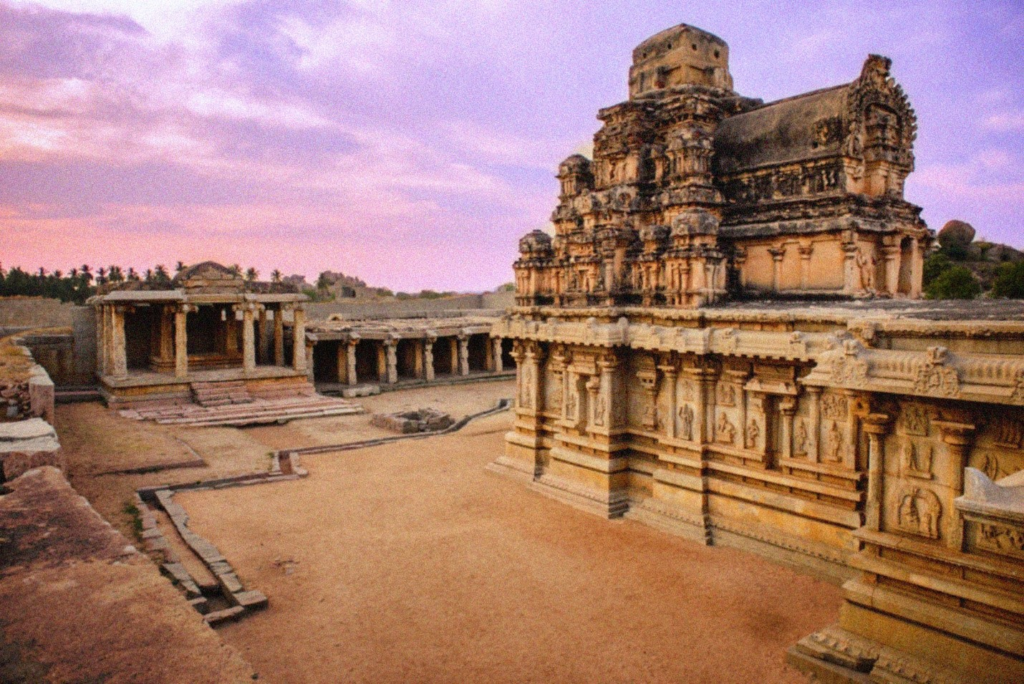
Later Conflicts and European Colonization (17th–20th Century CE)
From the 17th century, Tamil Nadu witnessed the emergence of new powers, both Indian and European, leading to significant socio-political changes.
Mughal Administration and Carnatic Nawabs:
- The Mughal Empire administered Tamil Nadu indirectly through the Nawab of the Carnatic, based in Arcot, who subdued the Madurai Nayaks.
- The 18th century saw attacks by the Marathas, leading to the short-lived Thanjavur Maratha Kingdom.
European Colonization:
Tamil Nadu’s strategic location along the Coromandel Coast attracted European powers, resulting in a prolonged contest for dominance.
- The Portuguese established a port at São Tomé near present-day Chennai in 1522.
- The Dutch set up their base in Pulicat, and the Danes in Tharangambadi.
- In 1639, the British East India Company acquired land from the Vijayanagar emperor to establish Fort St. George, marking the beginning of British influence.
- By the mid-18th century, the French, centered in Pondicherry, clashed with the British for control over Tamil Nadu. Key events included:
- The Battle of Madras (1746) and subsequent Battle of Wandiwash (1760), during the Seven Years’ War, which established British dominance.
Resistance to British Rule:
- The Palaiyakkarars (Polygars) resisted British expansion in the Polygar Wars. Early leaders like Puli Thevar, Rani Velu Nachiyar, and Kattabomman waged fierce battles against British authority.
- The Maruthu brothers and their allies formed coalitions that defied the British during the Second Polygar War.
- Conflicts with Mysore culminated in the Anglo-Mysore Wars, with the British emerging victorious by the late 18th century.
By the 19th century, Tamil Nadu was part of the Madras Presidency, under British administration. The Vellore Mutiny in 1806 was a significant early revolt against British rule.

Impact of British Rule and Indian Independence (19th–20th Century CE)
The British Raj brought both administrative changes and challenges to Tamil Nadu.
- Economic Impact: The Ryotwari system of revenue collection led to famines, including the devastating Great Famine of 1876–1878, which resulted in widespread migration of Tamils as bonded laborers, forming the Tamil diaspora.
- Cultural and Political Awakening: Tamil Nadu became a center for the Indian Independence Movement, producing leaders like V. O. Chidambaram Pillai, Subramaniya Siva, and Bharatiyar. The state also contributed significantly to the Indian National Army (INA), led by Subhas Chandra Bose.
Post-Independence Tamil Nadu (1947–Present)
After India gained independence in 1947, Tamil Nadu underwent several transformations:
- Formation of Tamil Nadu:
- The Madras Presidency became Madras State.
- In 1969, it was renamed Tamil Nadu, meaning “Tamil country.”
- The linguistic reorganization of states further shaped its boundaries.
- Social Movements: The anti-Hindi agitations of 1965 played a significant role in retaining English as an official language alongside Hindi.
- Economic Growth:
- Initially adopting a socialist framework, Tamil Nadu’s economy transitioned to reform-oriented policies in the 1970s, leading to consistent growth.
- Today, it is one of India’s most urbanized states, with a strong Human Development Index (HDI).
Environment and Geography of Tamil Nadu
Tamil Nadu, located on the southeastern coast of India, is a region rich in geographic diversity, climatic variations, and environmental significance. Its unique location and geological history contribute to its vibrant natural heritage.
Geography
Tamil Nadu spans an area of 130,058 km², making it the tenth-largest state in India. The state is surrounded by the Western Ghats and the Deccan Plateau to the west, the Eastern Ghats to the north, and the Eastern Coastal Plains bordering the Bay of Bengal in the east. To its south lies the Gulf of Mannar, Palk Strait, and Laccadive Sea, while its southernmost tip, Kanyakumari, marks the confluence of the Indian Ocean, Bay of Bengal, and Arabian Sea.
The state shares borders with Kerala, Karnataka, Andhra Pradesh, and the union territory of Puducherry. Additionally, Tamil Nadu shares an international maritime border with Sri Lanka, separated by the Palk Strait and Rama’s Bridge (Adam’s Bridge), a chain of sandbars and islands.

Key topographical highlights include:
- Western Ghats: Running along the western boundary, these ranges house Tamil Nadu’s highest peak, Doddabetta (2,636 meters).
- Eastern Ghats: Discontinuous ranges intersected by the Kaveri River, creating fertile lands.
- Nilgiri Hills: Forming the meeting point of the Eastern and Western Ghats, known for their biodiversity and tea plantations.
- Coromandel Coast: A flat coastal region along the Bay of Bengal, prone to cyclones and tsunamis.
Tamil Nadu boasts the second-longest coastline in India at 1,076 km, featuring coral reefs in the Gulf of Mannar. This coastline was significantly impacted by the 2004 Indian Ocean tsunami, altering its landscape permanently.
Geology
Tamil Nadu’s geological features reflect its ancient origins:
- The state is primarily in low seismic hazard zones (Zones II and III), except for moderate risks along its western border.
- The Deccan Traps, formed from volcanic eruptions during the late Cretaceous period, dominate the plateau’s geology.
- Soil Types:
- Red Soil: Found extensively across inland districts, rich in iron.
- Black Soil: Located in western regions, ideal for agriculture.
- Alluvial Soil: Found in the Kaveri Delta, among the state’s most fertile regions.
- Saline and Laterite Soil: Scattered along the coast and uplands.
Climate
Tamil Nadu experiences a tropical climate with distinct wet and dry seasons. It is classified into seven agro-climatic zones: northeast, northwest, west, southern, high rainfall, high altitude hilly, and Kaveri delta.
- Temperature:
- Summers (March–May): Extremely hot, with temperatures exceeding 50°C in low-lying areas.
- Winters: Mild, averaging 20–24°C in semi-arid regions.
- Rainfall:
- The southwest monsoon (June–September) accounts for 52% of annual rainfall, particularly benefiting the western regions.
- The northeast monsoon (November–March) contributes 48% of rainfall, significantly aiding northern and coastal Tamil Nadu.
- Annual Rainfall: Averages 945 mm, heavily dependent on monsoons.
Climatic Challenges:
- Tamil Nadu faces frequent droughts and acute water scarcity due to monsoon failures.
- The state is highly vulnerable to tropical cyclones, especially along the Coromandel Coast.
Environmental Significance
The state’s environment reflects a mix of natural beauty and ecological challenges:
- Biodiversity: The Nilgiris and Western Ghats are recognized as biodiversity hotspots.
- Coral Reefs: The Gulf of Mannar supports diverse marine ecosystems.
- Coastal Ecosystems: The Coromandel Coast hosts mangroves, lagoons, and sandy beaches, though these areas are threatened by erosion and human activities.
Flora and Fauna of Tamil Nadu
Tamil Nadu is a biodiversity-rich state with diverse ecosystems ranging from tropical rainforests to scrublands, coral reefs, and mangroves. Covering an extensive forest area of 22,643 km², which constitutes 17.4% of the state’s geographical expanse, Tamil Nadu supports a wide variety of flora and fauna shaped by its unique climate and topography.
Flora of Tamil Nadu
The state’s vegetation spans deciduous forests in the Western Ghats, tropical dry forests, and scrublands in interior regions. High-altitude rainforests in the southern Western Ghats, categorized as the South Western Ghats montane rain forests, are significant ecological treasures.
- Key Plant Species:
Common plant life includes palmyra palm (the state tree), teak, eucalyptus, rubber, and bamboo. Flowering trees like Indian laburnum and unique species such as Combretum ovalifolium, Habenaria rariflora, and ebony (Diospyros nilagrica) enhance the state’s botanical diversity.




- Medicinal Plants: Tamil Nadu is home to 1,559 medicinal plant species, emphasizing its traditional health practices and economic importance in herbal medicine production.
Fauna of Tamil Nadu
The state is home to over 2,000 species of wildlife, including several endangered species. Tamil Nadu’s unique positioning on biodiversity hotspots like the Western Ghats eco-region, a UNESCO World Heritage Site, bolsters its rich animal diversity.
- Prominent Mammals:
- Asian elephants (one of the largest populations in India).
- Nilgiri tahr (the state animal and an endangered species found in the Nilgiri Hills).
- Indian leopard, lion-tailed macaque, and grizzled giant squirrel.





- Birdlife:
The emerald dove (state bird) and a multitude of migratory birds thrive in Tamil Nadu’s bird sanctuaries, such as Vedanthangal, Pulicat, and Ranganathittu. - Marine Life:
Coral reefs in the Gulf of Mannar Biosphere Reserve harbor dolphins, dugongs, and sea cucumbers, highlighting the marine biodiversity.
Protected Areas in Tamil Nadu
Tamil Nadu has established significant protected zones to conserve its natural heritage, covering 3,305 km², or 2.54% of the state’s geographic area.
- National Parks:
- Mudumalai National Park: Established in 1940, the first wildlife sanctuary in South India.
- Others include Anamalai, Mukurthi, Gulf of Mannar, and Guindy (an urban national park in Chennai).
- Tiger Reserves:
Tamil Nadu contributes to Project Tiger with five reserves:- Anamalai
- Mudumalai
- Kalakkad-Mundanthurai
- Sathyamangalam
- Megamalai
- Elephant Sanctuaries:
- Agasthyamalai, Anamalai, Coimbatore, Nilgiris, and Srivilliputtur serve as conservation zones for elephants under Project Elephant.
- Mangroves and Marine Ecosystems:
- Pichavaram Mangrove Forest: One of India’s largest mangroves, covering 45 km², supports rare species of shells, fishes, and birds.
- Gulf of Mannar Marine National Park: Protects coral reefs and associated marine ecosystems.
Zoos and Conservation Projects
The state boasts several conservation initiatives, including:
- Arignar Anna Zoological Park and Madras Crocodile Bank Trust in Chennai.
- Smaller wildlife parks like Amirthi Zoological Park (Vellore) and Yercaud Deer Park.
- Crocodile farms in Amaravati, Hogenakkal, and Sathanur aim to conserve vulnerable reptile species.
Threatened and Endangered Species
Key endangered species include:
- Sloth bear
- Grey slender loris
- Nilgiri langur
- Royal Bengal tiger
State Symbols of Tamil Nadu
- State Animal: Nilgiri tahr (Nilgiritragus hylocrius).
- State Bird: Emerald dove (Chalcophaps indica).
- State Tree: Palmyra palm (Borassus flabellifer).
- State Butterfly: Tamil Yeoman (Cirrochroa thais).
- State Flower: Glory lily (Gloriosa superba).
- State Fruit: Jackfruit (Artocarpus heterophyllus).
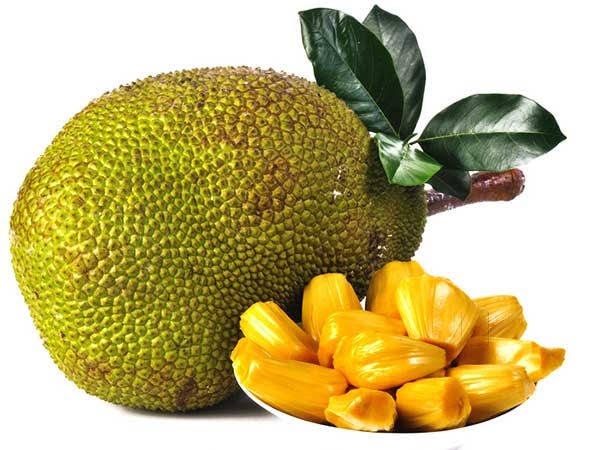
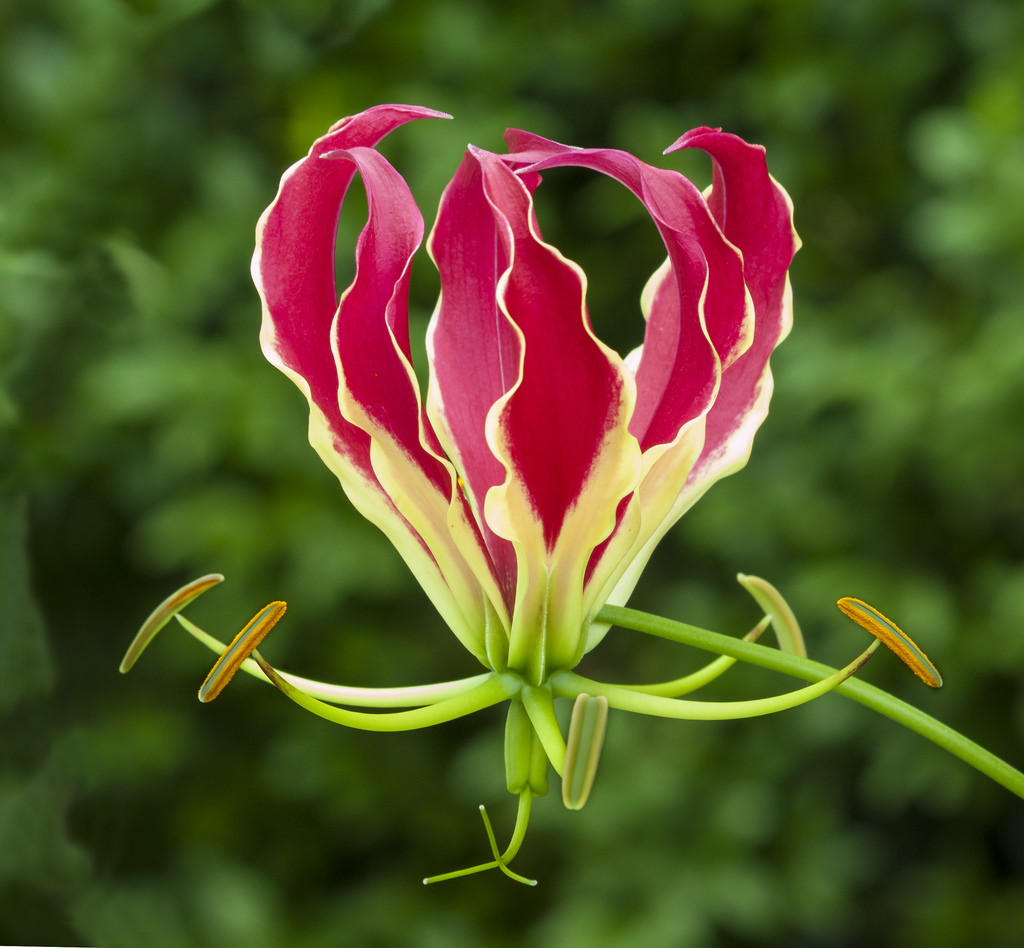




Administration and Politics of Tamil Nadu
Administration Structure
Tamil Nadu, with its capital at Chennai, operates under a well-defined administrative framework. The state government functions through 43 secretariat departments, each managing a range of subdivisions, boards, and undertakings. Tamil Nadu is divided into 38 districts, each governed by a District Collector, an Indian Administrative Service (IAS) officer appointed by the state government.
Revenue administration involves further division into 87 revenue divisions, 310 taluks, and 1,349 revenue blocks. These are subdivided into 17,680 revenue villages. The local governance system includes:
- Urban areas: 15 municipal corporations, 121 municipalities, and 528 town panchayats.
- Rural areas: 385 panchayat unions and 12,618 village panchayats managed by Village Administrative Officers (VAOs).
The Greater Chennai Corporation, established in 1688, is the second oldest municipal body globally. Tamil Nadu also pioneered the establishment of town panchayats as administrative units.
Legislature of Tamil Nadu
Tamil Nadu follows a unicameral legislature, the Tamil Nadu Legislative Assembly, housed in Fort St. George, Chennai. The governor, as the constitutional head, appoints the chief minister, who holds executive power.
Legislative History:
- Established under the Indian Councils Act of 1861, the legislature began as an advisory body.
- The Madras legislative council, formed in 1921, transitioned into a bicameral legislature in 1937.
- Following India’s independence, the 1952 elections led to the formation of Tamil Nadu’s first legislature under the Constitution.
- In 1986, the state abolished its Legislative Council, creating a unicameral system.
Tamil Nadu sends 39 members to the Lok Sabha and 18 to the Rajya Sabha, ensuring significant representation in India’s Parliament.
Law and Order
The Madras High Court, established on 26 June 1862, is Tamil Nadu’s apex judicial authority, with a bench in Madurai since 2004. The Tamil Nadu Police, founded in 1859, is among the nation’s largest police forces with over 132,000 personnel, led by a Director General of Police (DGP).
Women police officers account for 17.6% of the force, and there are 222 all-women police stations to handle crimes against women. Tamil Nadu also leads in infrastructure, boasting 1,854 police stations, the highest in India.
The state’s crime rate is relatively low, ranking Tamil Nadu as one of the safest states for women.
Politics in Tamil Nadu
Historical Evolution
Tamil Nadu’s political landscape evolved through a mix of national and regional influences:
- Early Influence: The Justice Party and Swaraj Party dominated the Madras Presidency politics in the early 20th century.
- Dravidian Movement: Leaders like E.V. Ramasamy (Periyar) and C.N. Annadurai led the Self-Respect Movement, forming the Dravidar Kazhagam and later, the Dravida Munnetra Kazhagam (DMK) in 1949.
- Post-Independence: The Indian National Congress dominated the political scene until the Anti-Hindi agitation in the 1960s fueled the rise of Dravidian parties.
The DMK formed Tamil Nadu’s first non-Congress government in 1967, followed by the All India Anna Dravida Munnetra Kazhagam (AIADMK) in 1972. Both parties have alternated in power since, dominating state politics.
Key Political Leaders and Contributions
- C.N. Annadurai: First DMK chief minister.
- M. Karunanidhi (DMK) and J. Jayalalithaa (AIADMK): Dominated Tamil Nadu politics for decades, serving as chief ministers for over 32 combined years.
- K. Kamaraj: Played a pivotal role in Congress leadership, influencing the selection of Indian prime ministers.
- M.G. Ramachandran (AIADMK): Founded the AIADMK, bringing significant social reforms.
Role in Indian Politics
Tamil Nadu has produced influential leaders, including three Indian presidents:
- Sarvepalli Radhakrishnan
- R. Venkataraman
- A.P.J. Abdul Kalam

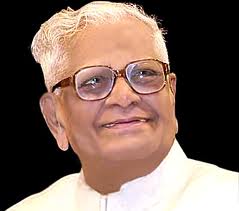

The state remains a stronghold for regional parties, with national parties usually acting as junior allies in state elections.
Women and Minority Representation
The state consistently leads in women’s political and administrative representation, while also ensuring minorities have a voice in governance.
Tamil Nadu’s politics is a testament to the strength of regional identity, linguistic pride, and social justice movements. It remains a unique case study in balancing federal and state interests in India.
Demographics of Tamil Nadu
Tamil Nadu, one of India’s most populous states, is a tapestry of cultural diversity, urbanization, and significant demographic milestones. Below is a comprehensive overview of its population dynamics, urban centers, religious composition, and ethnic groups.
Historical Population Growth
Tamil Nadu’s population has seen steady growth over the decades, as illustrated by census data.
| Year | Population | Growth (%) |
|---|---|---|
| 1901 | 19,252,630 | — |
| 1951 | 30,119,047 | +14.7% |
| 2001 | 62,405,679 | +11.7% |
| 2011 | 72,147,030 | +15.6% |
- Projection: By 2023, Tamil Nadu’s population is estimated to reach 76.8 million, growing to approximately 78 million by 2036.
Urbanization and Literacy
Tamil Nadu is one of India’s most urbanized states:
- Urban Population (2011): 48.4% of residents live in urban areas, reflecting significant urban development.
- Literacy Rate (2011): 80.1%, higher than the national average of 73%. As of 2017, it rose to 82.9%.
Population Composition
- Sex Ratio:
- 996 females per 1,000 males (2011), exceeding the national average of 943.
- At birth, the ratio declined to 878 females per 1,000 males (2019–2021 NFHS).
- Scheduled Castes (SCs): Constitute 20% of the population.
- Scheduled Tribes (STs): Represent 1.1% of the population.
Human Development Indicators
Tamil Nadu has achieved significant progress in human development:
- Fertility Rate (2017): 1.6 children per woman, the lowest in India.
- Life Expectancy (2019): 74 years, among the highest in the country.
- Human Development Index (2021): 0.686, higher than the national average (0.633).
- Poverty Rate (2023): Only 2.2% live below the poverty line, showcasing economic advancement.
Major Cities and Urban Agglomerations
The state is home to vibrant cities that serve as hubs for culture, commerce, and innovation.
| Rank | City | Population | District |
|---|---|---|---|
| 1 | Chennai | 8,696,010 | Chennai |
| 2 | Coimbatore | 2,151,466 | Coimbatore |
| 3 | Madurai | 1,462,420 | Madurai |
| 4 | Tiruchirappalli | 1,021,717 | Tiruchirappalli |
| 5 | Tiruppur | 962,982 | Tiruppur |
Other prominent cities include Salem, Erode, Vellore, Tirunelveli, and Thoothukudi.
Religious Composition
Tamil Nadu’s population is predominantly Hindu, with notable minorities contributing to its religious diversity.
| Religion | Percentage (2011) |
|---|---|
| Hinduism | 87.6% |
| Christianity | 6.1% |
| Islam | 5.86% |
| Jainism | 0.1% |
| Others/Not Stated | 0.3% |
- Cultural Impact: The state boasts an inclusive ethos, fostering communal harmony across diverse faiths.
Ethnic Diversity
Tamils form the majority ethnic group, but Tamil Nadu’s multicultural fabric includes:
- Minority Groups: Telugus, Kannadigas, Malayalees, Marwaris, Gujaratis, Sindhis, Anglo-Indians, and others.
- Expatriates: A significant portion of Tamil Nadu’s population resides overseas, contributing to its global identity.
Language and Cultural Identity in Tamil Nadu
Tamil Nadu is a state rich in linguistic heritage, where Tamil serves not only as the primary means of communication but also as a cornerstone of its cultural identity. The state also embraces linguistic diversity, reflecting its cosmopolitan ethos.
Language Distribution (2011 Census)
| Language | Percentage |
|---|---|
| Tamil | 88.35% |
| Telugu | 5.87% |
| Kannada | 1.78% |
| Urdu | 1.75% |
| Malayalam | 1.01% |
| Other Languages | 1.24% |
Tamil: The Core Identity
- Official Language: Tamil is the state’s official language and one of India’s classical languages, recognized for its antiquity and rich literary tradition.
- Usage: Spoken as the first language by 88.4% of the population, Tamil exhibits regional dialectal variations such as:
- Madras Bashai in northern Tamil Nadu.
- Kongu Tamil in western regions.
- Madurai Tamil in the central areas.
- Nellai Tamil in southeastern Tamil Nadu.
- Linguistic Features: Tamil retains elements of Proto-Dravidian roots while incorporating loanwords from Sanskrit and English, enriching its vocabulary.
Linguistic Diversity
While Tamil dominates, other languages add to the cultural tapestry:
- Telugu: The second-most spoken language, reflecting migration from neighboring Andhra Pradesh.
- Kannada, Urdu, and Malayalam: Spoken by minority communities, highlighting Tamil Nadu’s inclusive spirit.
- Foreign Languages: Expatriates bring languages like Korean, Japanese, French, Mandarin Chinese, German, and Spanish, especially in urban centers like Chennai.
LGBT Rights in Tamil Nadu
Tamil Nadu is a forerunner in progressive LGBTQ+ rights, setting benchmarks for inclusivity in India.
Key Milestones
- Transgender Welfare Board (2008):
- Tamil Nadu became the first Indian state to establish a welfare board for transgender people, ensuring free sex reassignment surgeries in government hospitals.
- Legal Recognition of Marriages (2019):
- The Madras High Court ruled that the term “bride” under the Hindu Marriage Act, 1955 includes transgender women, allowing marriages between men and trans women.
- Ban on Conversion Therapy (2021):
- Tamil Nadu became the first Indian state to outlaw:
- Conversion therapy aimed at changing an individual’s sexual orientation or gender identity.
- Forced sex-selective surgeries on intersex infants.
- Tamil Nadu became the first Indian state to outlaw:
- Chennai Rainbow Pride (Since 2009):
- The annual event celebrates LGBTQ+ rights, fostering awareness and acceptance.
Impact on Society
- Tamil Nadu’s policies have created a supportive environment for LGBTQ+ individuals.
- The state’s progressive stance influences national discourse on LGBTQ+ rights, positioning it as a leader in human rights advocacy.
Culture and Heritage of Tamil Nadu
Tamil Nadu is renowned for its vibrant culture, rich traditions, and profound heritage, which blend ancient customs with contemporary influences. Its clothing, cuisine, and literature reflect the region’s deep historical and cultural roots.
Traditional Clothing
For Women:
- Sari:
- The sari, a drape measuring 5 to 9 yards, is the quintessential attire for Tamil women. The midriff is often exposed, symbolizing life and creativity in Indian philosophy.
- Kanchipuram Silk Saris:
- Famous for intricate designs, these are worn on special occasions like weddings.
- Recognized as a Geographical Indication (GI) product in 2005–2006.
- Kovai Cora Cotton Saris:
- Made in Coimbatore, these cotton saris are lightweight and elegant.

For Men:
- Dhoti:
- A 15-foot-long, non-stitched white cloth with colored borders, wrapped around the waist and legs.
- Lungi:
- Popular in rural areas, lungis are colorful and feature batik patterns.
- In urban settings, western attire is common, and school uniforms for children reflect modern influences.
Cuisine: A Blend of Tradition and Flavor
Staple Diet:
- Rice is the foundation of Tamil meals, often served with sambar, rasam, and poriyal (vegetable stir-fry).
- Coconut and spices are integral to the cuisine, adding distinct aroma and flavor.
Traditional Practices:
- Meals are traditionally served on banana leaves and eaten by hand while seated on the floor.
- Banana leaves not only impart a unique taste but are eco-friendly and culturally significant.






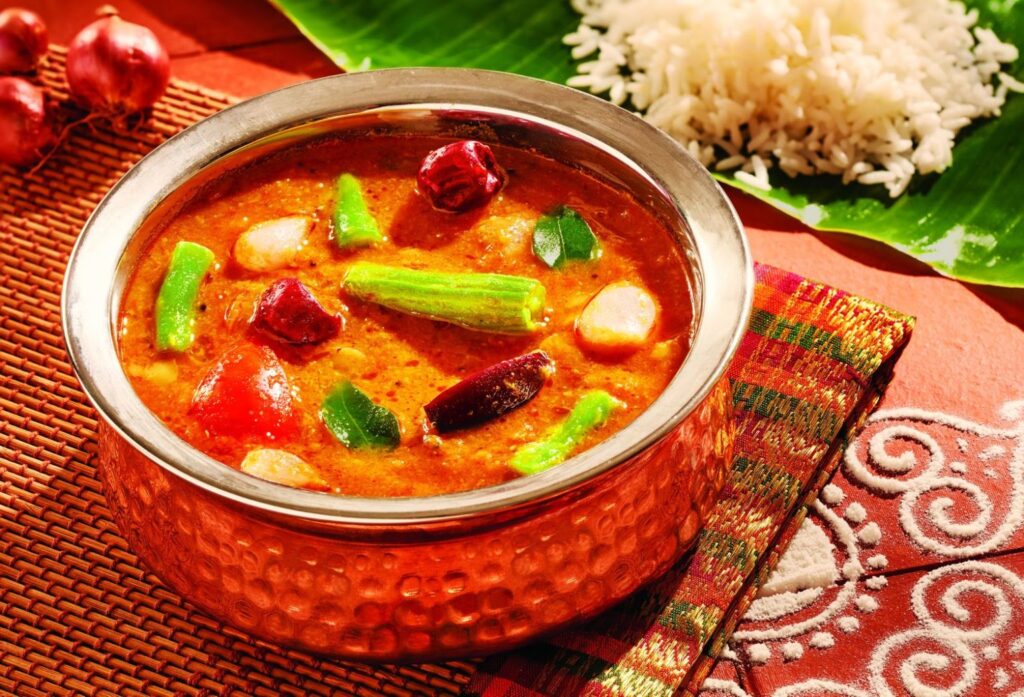

Popular Dishes:
- Breakfast Items:
- Idli, dosa, uthappam, pongal, and paniyaram are favorites.
- Snacks and Sweets:
- Unique GI-recognized foods include:
- Palani Panchamirtham (sweet mixture).
- Ooty Varkey (biscuit-like snack).
- Manapparai Murukku (crispy snack).
- Srivilliputhur Palkova (milk-based sweet).
- Unique GI-recognized foods include:
Literature: A Timeless Legacy
Tamil Nadu’s literary tradition dates back over 2,500 years, marking it as one of the oldest continuous literary cultures in the world.
Sangam Literature:
- Composed during the Sangam era, it includes:
- Tolkappiyam: The earliest Tamil grammar treatise.
- Cilappatikaram and Manimekalai: Epic poems showcasing Tamil culture and ethics.
Notable Works and Movements:
- Medieval Period:
- The Bhakti movement produced devotional hymns by Alvars (Vaishnava saints) and Nayanars (Shaivite saints).
- Kambar’s Ramavataram and Tiruppukal by Arunagirinathar are standout works.
- Colonial Period:
- The first Indian language book, Thambiraan Vanakkam, was printed in Tamil in 1578 by Portuguese missionaries.
- The Tamil Lexicon, published by the University of Madras, was India’s first dictionary.
- Tamil Renaissance (19th Century):
- Thinkers like Meenakshi Sundaram Pillai, U.V. Swaminatha Iyer, and Ramalinga Swamigal revitalized Tamil literature.
Modern Era:
- During the Indian Independence Movement, Tamil poets like Subramania Bharati infused literature with themes of nationalism, social equity, and secularism.
Culture and Heritage of Tamil Nadu: A Vibrant Mosaic of Tradition and Art
Tamil Nadu, a state in southern India, is renowned for its rich cultural heritage, art forms, traditional clothing, architectural marvels, and vibrant festivals. The legacy of this region reflects centuries of creativity, devotion, and intellectual pursuits.
Traditional Clothing: A Celebration of Elegance
Tamil Nadu’s clothing embodies both simplicity and grandeur. Women traditionally wear the sari, an elegant drape that symbolizes grace. The Kanchipuram silk sari, recognized for its intricate designs and vibrant colors, holds a special place, particularly during weddings and festivities. Men traditionally wear dhoti, a non-stitched white garment knotted at the waist, and lungis, which are common in rural areas.
Modern influences have brought tailored clothing and Western-style uniforms into urban and educational spaces. However, the traditional attire remains a cherished aspect of Tamil identity, blending seamlessly with contemporary styles.
Cuisine: Flavors of Tradition
Tamil Nadu’s cuisine is a harmonious blend of flavors, enriched by the use of coconut, spices, and lentils. The state’s culinary traditions, from idli and dosa to unique sweets like Palani Panchamirtham and Srivilliputhur Palkova, are beloved across India. Meals are traditionally served on banana leaves, reflecting eco-conscious practices and adding a distinct flavor to the food.
The culture of Tamil Nadu emphasizes hospitality, with meals being a heartfelt expression of warmth and community. Pongal, a dish made with rice and lentils, is both a staple and a ceremonial offering during the harvest festival of the same name.
Architecture: Monuments of Dravidian Brilliance
Tamil Nadu’s architectural heritage is best represented by its Dravidian temples, featuring majestic gopurams (gateway towers), vimanams (structures over sanctums), and intricate carvings. The temples, such as the Brihadisvara Temple in Thanjavur, are masterpieces of the Chola dynasty. The distinctive Indo-Saracenic style introduced during British rule adds to the state’s diverse architectural landscape.

The group of monuments at Mahabalipuram and the grandeur of temples in Madurai and Kanchipuram exemplify the artistic excellence of Tamil Nadu.
Dance and Music: Expressions of Art
The Bharatanatyam, one of India’s oldest classical dance forms, originated in Tamil Nadu and is celebrated worldwide for its spiritual depth and artistic precision. Regional dances like Karakattam and Oyilattam depict the state’s folk traditions, while Koothu merges storytelling with performance art.
Tamil Nadu’s music, rooted in Carnatic traditions, has produced legendary composers like Muthuswami Dikshitar. Instruments like the nadaswaram and thavil hold a special place in temple rituals and weddings, underscoring the spiritual essence of Tamil music.





Literature: Timeless Treasures
Tamil Nadu boasts a literary tradition spanning over 2,500 years. The Sangam literature, epics like Silappatikaram, and ethical works such as the Tirukkural reflect the richness of Tamil thought and philosophy. The state has continually produced works that advocate for social justice, equality, and patriotism, with modern writers like Subramania Bharati playing pivotal roles during India’s independence movement.
Festivals: A Celebration of Life
Tamil Nadu’s festivals are vibrant expressions of its cultural ethos. Pongal, the harvest festival, embodies gratitude to nature, while Jallikattu, a traditional bull-taming sport, showcases the community’s spirit. Other festivals like Karthikai Deepam, Thaipusam, and Aadi Perukku are marked by devotion and community gatherings.
Music festivals like the Madras Music Season and Tyagaraja Aradhana further enrich Tamil Nadu’s cultural calendar, drawing artists and audiences from across the globe.



The Arts: A Testament to Creativity
Tamil Nadu is home to numerous museums, galleries, and the Kollywood film industry, which is a significant part of Indian cinema. The state’s contributions to visual and performing arts have been instrumental in shaping India’s cultural narrative.
Tamil Nadu’s Government Museum in Chennai, one of India’s oldest, and the vibrant traditions of Chennai Sangamam and Chennaiyil Thiruvaiyaru, celebrate the artistic legacy of this dynamic state.
Tamil Nadu’s culture and heritage are an enduring testament to its rich history, artistic excellence, and spiritual depth. It stands as a beacon of India’s diversity, where tradition and modernity coexist in harmony.

Economy of Tamil Nadu
Tamil Nadu has a well-diversified economy that consistently outperforms national growth rates due to its progressive economic policies and industrialization. As of December 2023, the state’s Gross State Domestic Product (GSDP) stood at ₹27.22 trillion (US$330 billion), the second-highest among Indian states. This marks a significant increase from ₹2.19 trillion (US$26 billion) in 2004. The state’s per capita Gross State Domestic Product (GSDP) is ₹315,220 (US$3,800), reflecting its relatively high standard of living. Despite these positive figures, rural unemployment remains a challenge, with the rural unemployment rate significantly higher than the national average.

Key Sectors Driving the Economy
Services Sector
The services sector is a major contributor to Tamil Nadu’s economy, accounting for 55% of the GSDP as of 2022. The state is a leading player in India’s Information Technology (IT) sector, with Chennai emerging as one of the key cities for IT exports. With significant investments in software services, Tamil Nadu has earned the title of “SaaS Capital of India.” The state hosts several IT parks, including the pioneering Tidel Park in Chennai, which was among Asia’s largest IT parks when established in 2000.
Additionally, the state’s financial services sector is thriving. Tamil Nadu has the headquarters of more than 400 financial companies, including several banks. The state is home to India’s first European-style banking system, which dates back to the late 17th century. The Reserve Bank of India’s southern zonal office is also based in Chennai.
Manufacturing Sector
Manufacturing is another vital aspect of Tamil Nadu’s economy, contributing 32% to its GSDP. The state is known for its strong presence in automotive, electronics, textiles, and leather industries.
- Automotive: Chennai has earned the nickname “Detroit of India” due to its extensive automotive manufacturing base. The city accounts for over 35% of India’s total automobile production, housing major manufacturers like Hyundai, Ford, and Renault-Nissan.
- Textiles: The textile industry in Tamil Nadu is one of the largest in India. Coimbatore, often referred to as the “Manchester of South India,” is a major hub for cotton and textile production. The state contributes significantly to India’s textile exports, with cities like Tiruppur specializing in knitted garments. Tamil Nadu is also home to numerous fiber textile mills, contributing over half of the country’s total.
- Electronics and Defense: Tamil Nadu is a leader in electronics manufacturing, generating $5.37 billion in 2023. The state is also home to defense manufacturing companies, such as AVANI in Chennai, which produces armored vehicles and tanks for the Indian Armed Forces.
- Leather: The leather industry is another stronghold, with Tamil Nadu accounting for 40% of India’s leather exports. The city of Ambur is well-known for its leather goods, including footwear.
Agriculture
Agriculture remains an essential part of Tamil Nadu’s economy, contributing around 13% to the GSDP. The state is known for its agricultural productivity, especially in rice, sugarcane, cotton, and groundnuts. Tamil Nadu is also a major producer of fruits like bananas, mangoes, and papayas, and vegetables such as onions, tomatoes, and chilies. The state benefits from extensive irrigation, particularly from the Cauvery River, which supports farming activities in the southern and central regions.
Energy Sector
Tamil Nadu is a leader in renewable energy, particularly wind power. The state contributes significantly to India’s total wind energy capacity and has been at the forefront of adopting solar power. It is also home to several thermal power plants and nuclear energy facilities, including the Kudankulam Nuclear Power Plant, making it one of the most energy-secure states in India. The state’s energy policies have been instrumental in driving the growth of its industrial and manufacturing sectors.
Infrastructure
Tamil Nadu boasts a robust infrastructure that supports its industrial and commercial activities. The state has a well-developed road network, with highways connecting all major cities and towns. Chennai is a major port city and one of the largest container ports in India, contributing significantly to international trade.
The state also has an extensive railway network, which plays a crucial role in the transportation of goods and people. In the aviation sector, Tamil Nadu is well-served by several international and domestic airports, including Chennai International Airport, which handles both cargo and passenger traffic.
Agriculture
Agriculture plays a significant role in Tamil Nadu’s economy, contributing 13% to the state’s Gross State Domestic Product (GSDP) and serving as a key employment generator in rural areas. As of 2022, Tamil Nadu had approximately 6.34 million hectares under cultivation. Rice, the state’s staple food grain, is one of the major crops, and Tamil Nadu ranks among the largest producers of rice in India, with an output of 7.9 million tonnes in 2021–22. The Kaveri delta region, often referred to as the “Rice Bowl of Tamil Nadu,” is particularly known for its rice production.
Major Crops and Produce
- Rice: Tamil Nadu is a significant contributor to India’s rice production, especially in the Kaveri delta, which is fertile and irrigated by the river.
- Sugarcane: Tamil Nadu is a major producer of sugarcane, with an annual output of 16.1 million tonnes in 2021–22.
- Spices and Oilseeds: The state is the leading producer of various spices, including pepper and cardamom, and also dominates in the production of oilseeds, especially groundnut.
- Fruits and Vegetables: Tamil Nadu is a leading producer of bananas and mangoes, contributing over 78% of India’s fruit cultivation area. The state also accounts for 6.5% of the national fruit production and 4.2% of vegetables.
- Natural Rubber and Coconut: Tamil Nadu is the second-largest producer of natural rubber in India and also produces a significant quantity of coconuts.
- Tea: The hill stations of Tamil Nadu, such as the Nilgiris, are known for their unique Nilgiri tea, which is a specialty of the region.
Animal Husbandry and Fisheries
Tamil Nadu has a robust poultry and egg industry, being the largest producer in India with an annual production of 20.8 billion units, contributing to over 16% of the national output. The state’s fishing industry is also significant, with a population of 1.05 million fishermen. Tamil Nadu’s coastline includes three major fishing harbors and 363 fish landing centers, contributing to 5% of India’s total fish production, with output reaching 0.8 million tonnes in 2022. Aquaculture, including shrimp, seaweed, mussel, clam, and oyster farming, is also prevalent, covering more than 6,000 hectares.





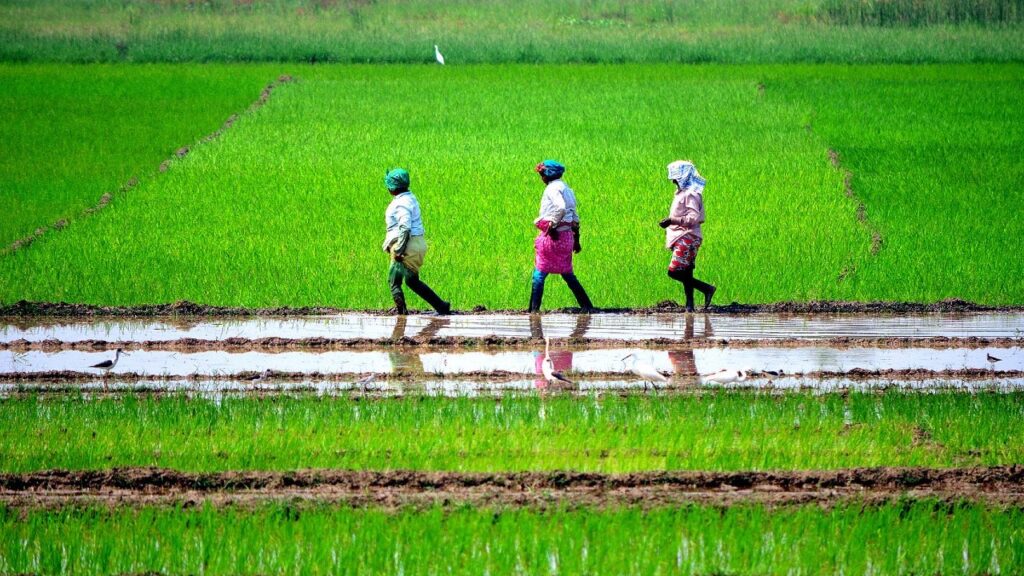
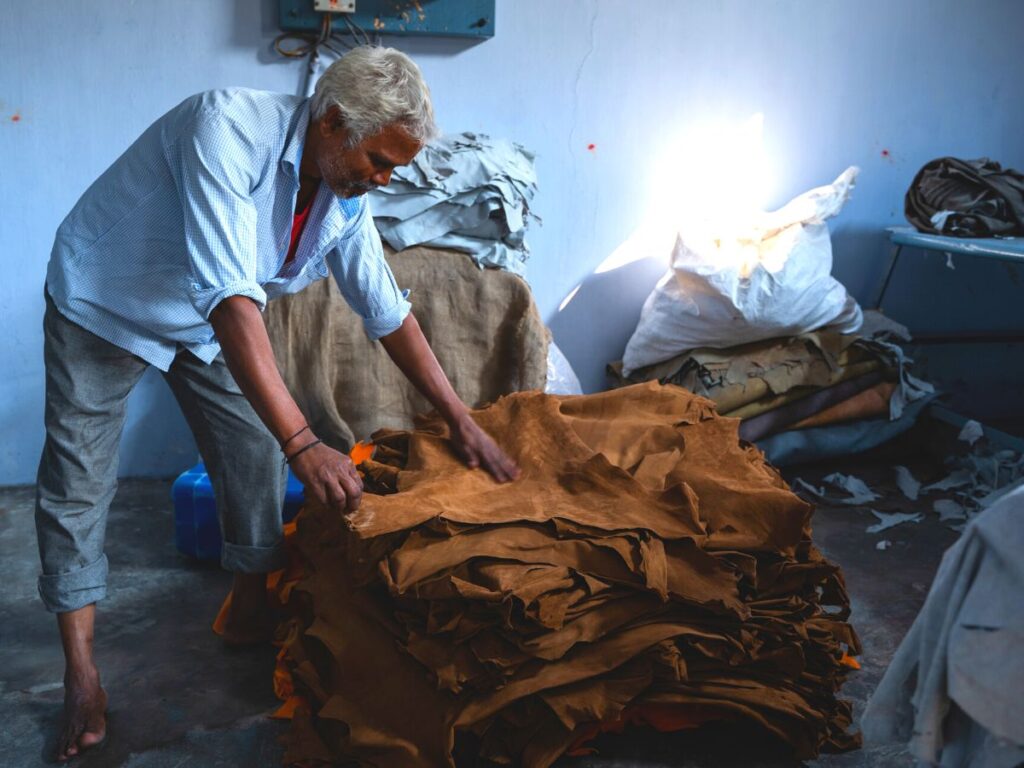




Infrastructure
Water Supply
Water scarcity remains a challenge in Tamil Nadu, despite its agricultural strength. The state holds nearly 4% of India’s land area but has only 3% of the country’s water resources. The per capita water availability is significantly lower than the national average, which places the state in a critical position regarding water management. Major rivers like the Kaveri, Bhavani, Vaigai, and Thamirabarani provide much-needed water for irrigation. However, Tamil Nadu depends on neighboring states for substantial water resources, leading to occasional inter-state water disputes.
The state’s water supply system includes over 41,000 tanks, 1.68 million wells, and 116 large dams. Desalination plants, including the largest at Minjur, supplement the state’s water needs, particularly for urban areas like Chennai. As of the 2011 census, 83.4% of households in the state had access to safe drinking water, which is below the national average.
Health and Sanitation
Tamil Nadu is one of the leading states in terms of sanitation, with more than 99.96% of its population having access to toilets. The state has excellent health infrastructure, with over 400 public hospitals, 1,776 dispensaries, and 11,030 health centers. Tamil Nadu also ranks highly in health metrics such as life expectancy (74 years) and institutional delivery (98.4%).
The General Hospital in Chennai, established in 1664, was India’s first major hospital. The state is a hub for medical tourism, particularly in Chennai, which is referred to as “India’s health capital.” More than 40% of all medical tourists visiting India come to Tamil Nadu for treatment. The government also runs extensive immunization programs, such as free polio vaccinations.
Power and Energy
Tamil Nadu is a major player in India’s energy sector. The state has the third-highest installed power capacity at 38,248 MW, with renewable sources like wind power contributing more than half of the total energy generated. The state is the leader in wind power, with over 8,000 MW of installed capacity, and is home to Muppandal, one of the world’s largest onshore wind farms.
The state also has two operational nuclear power plants, including the Kudankulam Nuclear Power Plant, which is India’s largest. Despite producing a significant amount of its own power, Tamil Nadu meets 60% of its electricity demand through purchases from other states.
Communication and Media
Tamil Nadu is well-connected with modern communication infrastructure. The state is one of four in India connected by undersea fiber-optic cables, and mobile service providers like Airtel, BSNL, Vodafone Idea, and Jio offer 4G and 5G services across the state. Tamil Nadu also has a high rate of internet penetration, with widespread broadband services provided by several operators.
The media landscape in Tamil Nadu is diverse, with multiple newspapers published in Tamil, English, and other regional languages. The state is home to India’s largest private TV broadcaster, Sun Network, and several other satellite television channels. Tamil Nadu also has a strong radio presence, with both AM and FM stations operated by All India Radio, as well as private stations like Radio Mirchi and Suryan FM. Television services are widely accessible, especially after the government’s initiative to distribute free televisions to households in 2006.
Other Services
- Fire Services: Managed by the Tamil Nadu Fire and Rescue Services, the state operates 356 fire stations to address fire-related emergencies.
- Postal Services: India Post operates more than 11,800 post offices in Tamil Nadu, making postal services accessible even in remote areas.
Overall, Tamil Nadu’s infrastructure in water supply, health, energy, and communication is well-developed, supporting its economic growth and improving the quality of life for its citizens. However, challenges remain, especially in managing water resources and ensuring equitable access to these services.
Transportation
Roads
Tamil Nadu boasts an extensive road network, with a total length of about 271,000 km as of 2023. This is significantly higher than the national average, with a road density of 2,084.71 kilometers per 1000 km². The state’s Highways Department, established in 1946, oversees the construction and maintenance of national highways, state highways, and other roads. The network includes 48 National Highways, totaling 6,805 kilometers in length, and state highways that connect major towns and cities within the state.
Tamil Nadu is home to 32,598 buses, with the Tamil Nadu State Transport Corporation (TNSTC) operating a vast fleet. The state’s road network also includes private buses and minibuses, making it a well-connected region for intra- and inter-state travel. The Kathipara Flyover in Chennai is one of the notable infrastructure developments, aimed at easing traffic congestion in urban areas.
Rail
Tamil Nadu’s rail network is part of the Southern Railway zone of Indian Railways, headquartered in Chennai. As of 2023, the state had a railway track length of 5,601 km, covering 3,858 km of routes. Key stations include Chennai Central, Chennai Egmore, Coimbatore Junction, and Madurai Junction, which are among the top revenue-generating stations.
The state also has a suburban railway network serving Chennai, which spans 212 km and has been operational since 1928. In addition to the traditional railway system, Tamil Nadu also features the Nilgiri Mountain Railway, a rack railway built by the British in 1908, which is the only one of its kind in India. The Chennai Metro, inaugurated in 2015, has two operational lines covering 54.1 km, adding to the state’s urban transit options.
Air and Space
Tamil Nadu has a significant aviation history, starting with the first powered flight in Asia in 1910. The state is home to several international and domestic airports. Chennai International Airport, one of the busiest airports in South Asia, serves as the primary international gateway. Coimbatore, Tiruchirapalli, and Madurai have international airports, while smaller domestic airports such as Tuticorin and Salem offer regional connectivity. The state’s airspace is under the purview of the Southern Air Command of the Indian Air Force, which operates airbases in Sulur, Tambaram, and Thanjavur. Furthermore, ISRO (Indian Space Research Organisation) has plans to set up a new rocket launch pad in Thoothukudi.
Waterways
Tamil Nadu has a robust port network, with three major ports—Chennai, Ennore, and Thoothukudi—handling significant maritime traffic. Additionally, there is an intermediate seaport at Nagapattinam and several smaller minor ports. The state’s ports are managed by the Ministry of Ports, Shipping, and Waterways of the Government of India. Tamil Nadu’s strategic coastal location also makes it vital to both the Eastern and Southern Naval Commands of the Indian Navy, which have major bases in Chennai and Thoothukudi.
Education
Literacy and School Enrollment
Tamil Nadu is one of the most literate states in India, with a literacy rate of 82.9% as of the 2017 National Statistical Commission survey, which is above the national average of 77.7%. The state’s rapid literacy growth, particularly since the 1960s, can be attributed to progressive educational initiatives like the midday meal scheme introduced by K. Kamaraj, aimed at increasing school enrollment.
In 1982, this scheme was upgraded to the Nutritious Noon-Meal Scheme to combat malnutrition among children. By 2022, Tamil Nadu had achieved a 95.6% enrollment in secondary education, significantly surpassing the national average of 79.6%. However, studies, such as those conducted by Pratham, have pointed out issues with the quality of education in comparison to other states, despite a low drop-off rate.
School System and Teacher-Pupil Ratio
As of 2022, Tamil Nadu is home to 37,211 government schools, 8,403 government-aided schools, and 12,631 private schools, catering to millions of students across the state. These schools educate approximately 5.47 million, 2.84 million, and 5.69 million students, respectively. The state employs 3,12,683 teachers, with an average teacher-pupil ratio of 1:26.6, which is generally favorable for student-teacher interaction. Tamil Nadu’s public schools follow the Tamil Nadu State Board curriculum, while private institutions may be affiliated with various boards, including the CBSE, ICSE, or NIOS. School education in Tamil Nadu follows the 10+2 plan, which includes two years of kindergarten, followed by ten years of school education and two years of higher secondary education.
Higher Education
Tamil Nadu has a vibrant higher education landscape with 56 universities as of 2023, including 24 public universities, 4 private universities, and 28 deemed-to-be universities. Among the oldest and most prestigious institutions is the University of Madras, founded in 1857. Tamil Nadu also boasts a large number of engineering colleges, including the Indian Institute of Technology Madras (IIT Madras) and the College of Engineering, Guindy, established in 1794, making it the oldest engineering college in India. The state is also home to numerous polytechnic colleges, arts and science colleges, and medical colleges, including the renowned Madras Medical College, established in 1835.

Specialized Institutes and Research
Tamil Nadu is a hub for research institutions, particularly in agriculture and forestry. Notable institutions include the Tamil Nadu Agricultural University, Central Institute for Cotton Research, Sugarcane Breeding Research Institute, and the Institute of Forest Genetics and Tree Breeding (IFGTB). The state is also home to ten institutes of national importance, further contributing to its reputation as an educational powerhouse. Connemara Public Library, established in 1896, is one of the oldest libraries in India and serves as one of the four National Depository Centres, receiving copies of all newspapers and books published in the country. Another significant library, the Anna Centenary Library, is the largest in Asia.
Educational Equity and Research Institutions
Tamil Nadu has a 69% reservation in educational institutions for socially backward sections of society, the highest among Indian states. The state’s commitment to educational equity is reflected in its support for socially backward communities, ensuring greater access to education for all. Along with its focus on quality education, Tamil Nadu also hosts several significant research institutes across diverse fields, providing opportunities for innovation and learning.
The state also holds an annual Chennai Book Fair, organized by the Booksellers and Publishers Association of South India (BAPASI), typically in December–January, which attracts bibliophiles, researchers, and academics from all over the country.
Tourism and Recreation
Overview
Tamil Nadu boasts a vibrant tourism industry, driven by its diverse culture, historical architecture, and varied geographies. The state’s rich cultural heritage, coupled with natural beauty, has made it one of the top destinations for both domestic and international tourists. In 1971, the Tamil Nadu Tourism Development Corporation (TTDC) was established to promote tourism and develop tourist infrastructure. Managed by the Tourism, Culture, and Religious Endowments Department, Tamil Nadu adopted the slogan “Enchanting Tamil Nadu” for tourism promotion. As of 2020, Tamil Nadu recorded the highest number of tourist footfalls in India, with more than 140.7 million tourists visiting the state.
Beaches and Coastline
With a 1,076 km long coastline, Tamil Nadu offers many scenic beaches that attract both locals and tourists alike. One of the most famous is Marina Beach, spanning 13 km (8.1 miles), making it the second-longest urban beach in the world. The state’s coastline is dotted with serene beaches, offering a range of activities from leisurely strolls to water sports, making it a popular destination for beach lovers.





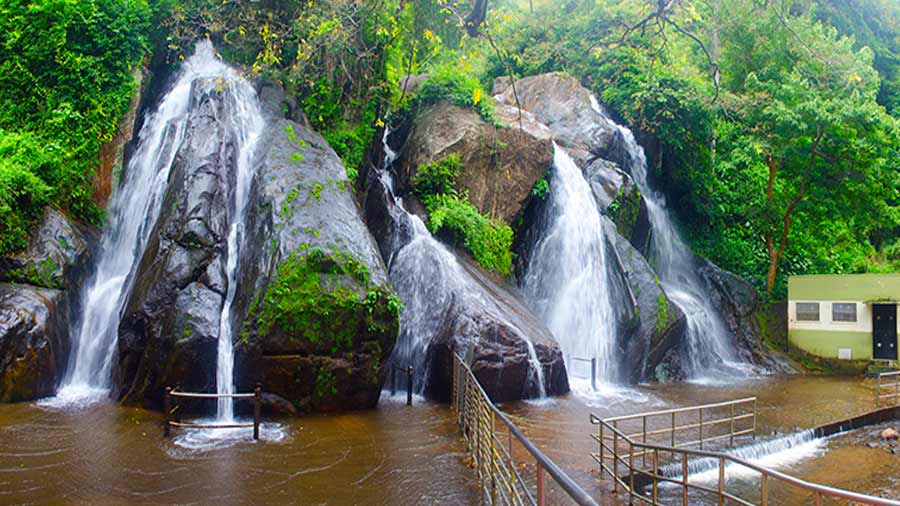








Hill Stations and Scenic Spots
The state is graced by the Western and Eastern Ghats, which house numerous hill stations, offering a cool retreat from the tropical climate. Some of the most popular hill stations in Tamil Nadu include Udagamandalam (Ooty) in the Nilgiri Hills and Kodaikanal in the Palani Hills. These hill stations are known for their lush greenery, pleasant weather, and picturesque landscapes, attracting nature enthusiasts, adventure seekers, and families alike.
Temples and Cultural Heritage
Tamil Nadu is known for its historical temples, with over 34,000 temples scattered across the state. These temples span various periods of history, showcasing impressive architectural styles, including the Dravidian style of architecture. Among the most famous are the Great Living Chola Temples, which are part of the UNESCO World Heritage Sites. The state is also home to numerous rock-cut cave temples, which offer a glimpse into Tamil Nadu’s rich spiritual and architectural heritage.
Waterfalls and Natural Beauty
The state’s many rivers and streams give rise to several stunning waterfalls, making Tamil Nadu a haven for nature lovers. Two of the most famous waterfalls are Courtallam Falls and Hogenakkal Falls, both of which are popular spots for tourists seeking tranquility and natural beauty.
UNESCO World Heritage Sites
Tamil Nadu is home to four UNESCO World Heritage Sites, which highlight its rich historical and natural legacy. These are:
- Group of Monuments at Mahabalipuram – Famous for its ancient rock-cut temples and monuments.
- Great Living Chola Temples – These temples, including the Brihadeeswarar Temple in Thanjavur, are prime examples of Tamil architecture.
- Nilgiri Mountain Railway – A historic railway line running through the Nilgiri Hills, recognized for its contribution to heritage and tourism.
- Nilgiri Biosphere Reserve – Known for its rich biodiversity, this reserve is a critical ecological hotspot in southern India.
Sports in Tamil Nadu
Tamil Nadu is a state with a deep-rooted connection to sports and traditional games, offering a blend of modern competitive sports and cultural pastimes. Its contributions to national and international sports, coupled with traditional practices, make it a unique sporting destination in India.
Kabaddi: The State Game
Kabaddi, a contact sport, is the official state game of Tamil Nadu. The sport has been celebrated for generations and continues to thrive at both local and professional levels. The Pro Kabaddi League has elevated its popularity, with the Tamil Thalaivas representing the state in this premier competition.
Traditional Games and Martial Arts
Tamil Nadu is a treasure trove of traditional games like:
- Pallanguzhi: A strategy game played with seeds and a wooden board.
- Uriyadi: A festive sport involving breaking a suspended pot.
- Gillidanda: An outdoor game akin to cricket.
- Dhaayam: A dice-based game.
In addition, bull-taming sports such as Jallikattu and Rekla (bullock cart racing) are integral to Tamil Nadu’s rural festivities. The state is also known for its martial arts, including Silambattam (stick fighting), Gatta Gusthi (traditional wrestling), and Adimurai (an ancient combat form).
Chess: “India’s Chess Capital”
Tamil Nadu is a hub for chess, often referred to as “India’s Chess Capital”. The game, believed to have originated as Sathurangam in Tamil Nadu during the 7th century CE, remains immensely popular.
- Chennai is home to several chess grandmasters, including Viswanathan Anand, a five-time world champion.
- The city hosted landmark events like the World Chess Championship 2013 and the 44th Chess Olympiad in 2022.
Cricket: The Most Popular Sport
Cricket reigns supreme in Tamil Nadu.
- The M.A. Chidambaram Stadium in Chennai, established in 1916, is one of India’s oldest crickets grounds and has hosted matches during multiple ICC Cricket World Cups.
- Chennai is home to the Chennai Super Kings (CSK), the most successful franchise in the Indian Premier League (IPL), with a massive fan following.
- The MRF Pace Foundation, based in Chennai, is a prestigious bowling academy that has produced many Indian cricketing legends.
Football and Hockey
Football enjoys a growing fan base in Tamil Nadu, with Chennaiyin FC representing the state in the Indian Super League (ISL). Hockey is also prominent, with the Tamil Nadu Hockey Association governing the sport in the region. The Mayor Radhakrishnan Stadium in Chennai has hosted international events like the 2005 Men’s Champions Trophy and the 2007 Men’s Asia Cup.
Motorsports and Racing
Tamil Nadu has carved a niche for itself in motorsports:
- Madras Motor Racetrack: India’s first permanent racing circuit, inaugurated in 1990, hosts formula racing events.
- Coimbatore is known as “India’s Motorsports Hub”, housing the Kari Motor Speedway, a Formula 3 category circuit.
- Horse racing is held at the Guindy Race Course, another favorite among enthusiasts.















Other Sporting Highlights
- Multi-purpose venues in Chennai and Coimbatore host various sports, including volleyball, basketball, and table tennis.
- Sailing, rowing, and canoeing are promoted by institutions like the Madras Boat Club and the Royal Madras Yacht Club.
- Golf courses such as the Cosmopolitan Club, Gymkhana Club, and Coimbatore Golf Club cater to golf aficionados.
Conclusion
Tamil Nadu’s sports culture is a rich tapestry of traditional games, modern sports, and world-class infrastructure. From the rustic charm of Kabaddi and Jallikattu to the glitz of cricket and motorsports, the state showcases a unique fusion of the old and the new, making it a dynamic and celebrated sporting hub in India.

